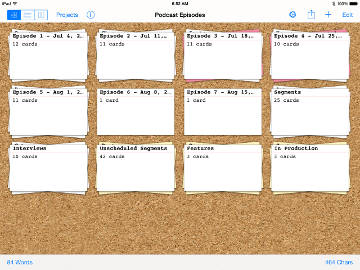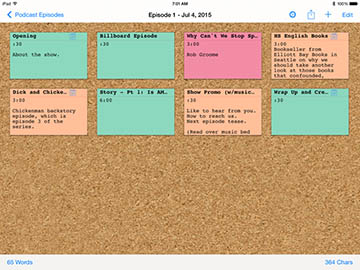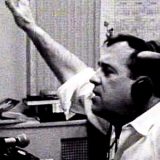Index Card—Podcasting Made Easier, Marriages Made Better
Whether you’re new to podcasting, or have an episode count in the triple digits, Index Card, an iPad app, could easily become the most useful tool in your production workflow—even more than your editing software. I’ve used Index Card for years in my writing and now I don’t put a podcast episode together without it.
As its name implies, Index Card uses the visual metaphor of a cork board and index cards, which you can work with just the way you work with a real-world cards. You can write on them, move them around, stack them, unstack them and jot down notes on the back. The only difference is that you no longer have to arrange your cards all over the living room floor, something that makes my wife surly. (Full Disclosure: Surly is not the word she used, but as long as I’m writing this blog it’s going to be G rated.)
My episodes are made up of multiple segments, each of which is either a short interview, a mini-news report, a show promo, a humorous story, a lifestyle tip or a longer feature report. I try to keep the time of each show to about 17 minutes, so advance planning is more than useful, it helps make the show manageable.
I create a card for each segment and write down a title, a general synopsis of the segment and an estimate of the segment’s running time. By clicking on the little notebook in the upper right I can flip the card over and write additional notes, the segment’s opening and closing scrips and my clever ad libs.
Then I color code the cards to indicates the status of each segment: just an idea; guests lined up; all content recorded; segment edited; and ready for air. One glance at my iPad (instead of the living room floor) and I know how each show is coming together and where I need to put my energy.
Since it’s easy to drag the cards around I have the freedom to experiment with show order, which I do obsessively during the week before I record a show. It’s not nearly as time-intensive as reordering the show by editing it, which my wife also appreciates because she insists that when I edit for too long I get surly. (See the definition of surly above.)
But even if your show has fewer moving parts, Index Card can make your production workflow smoother and more professional. For example, you can use Index Card to prep for interviews. Put a question on each card. On the back of the card, write any additional material you want to incorporate into the question. For example, if the question was prompted by something you read in a post, write that reference down and use it to frame your question for both your guest and your audience.
Since Index Card lets you print out the contents of your cards, you only need a few clicks to have a nice set of notes to use during your interview. Afterwards, listen to your recording and add the gist of each answer to the appropriate card. When you, or your editor, sit down to edit you’ll have a handy guide for structuring the show. (PS: Unless you are a very skilled live interviewer the chances are your interview will benefit from editing. This is not a sign of weakness. The most successful interview shows, from 60 Minutes to Fresh Air edit their interviews. I’m guessing there’s a reason behind it.)
These are the basics of Index Card, but the app offers far more features. I don’t need to add an image to a card, select from multiple card views, change a card’s orientation, but your mileage may vary.
As a former software developer, myself, I appreciate how Index Card’s developers, Dennis Vogel and Finn, obsessed over every part of the app, from its internals to its feature set and user interface. I can tell you from experience Dennis is extremely conscientious and user-focused and the app’s support is first-rate.
Give Index Card a try and let me know what you think. And, please share how you use it in your podcasts, which you can do by leaving a comment. I’m not saying Index Card will save your marriage, but it didn’t do mine any harm.
You can learn more about Index Card on its home page or in the iTunes Store.








